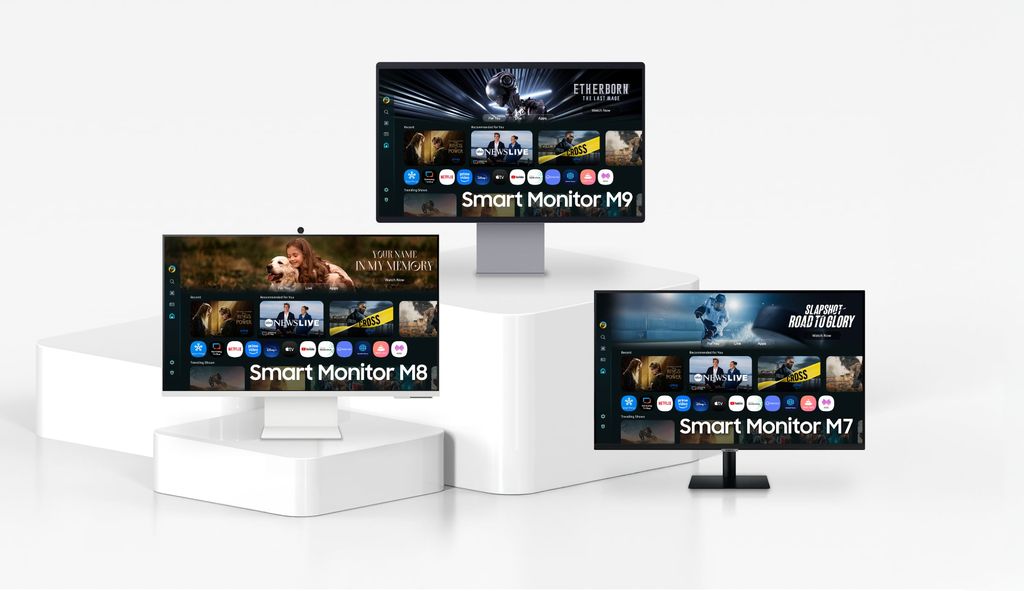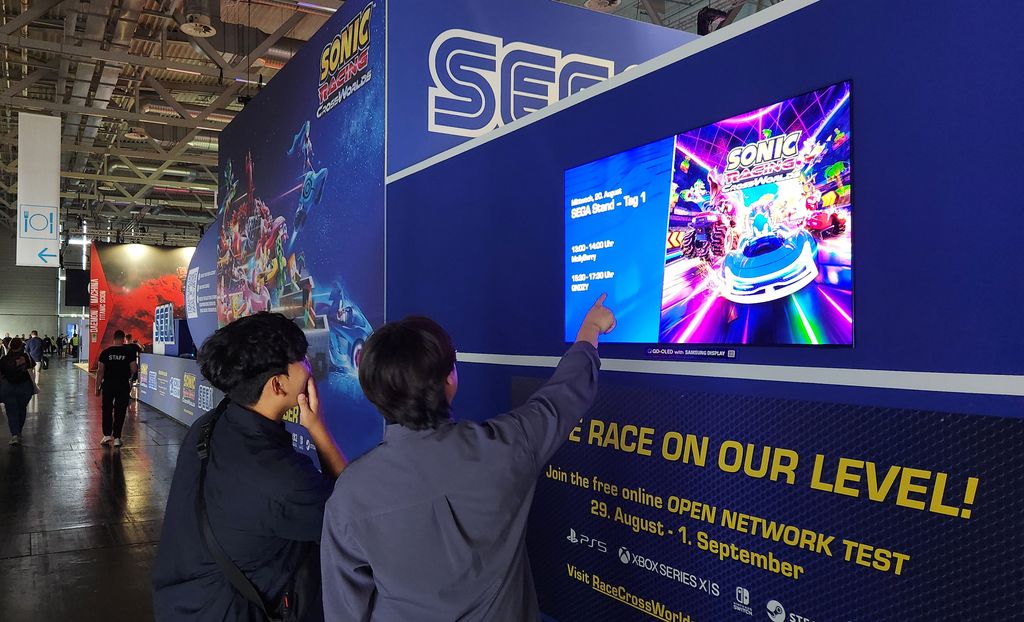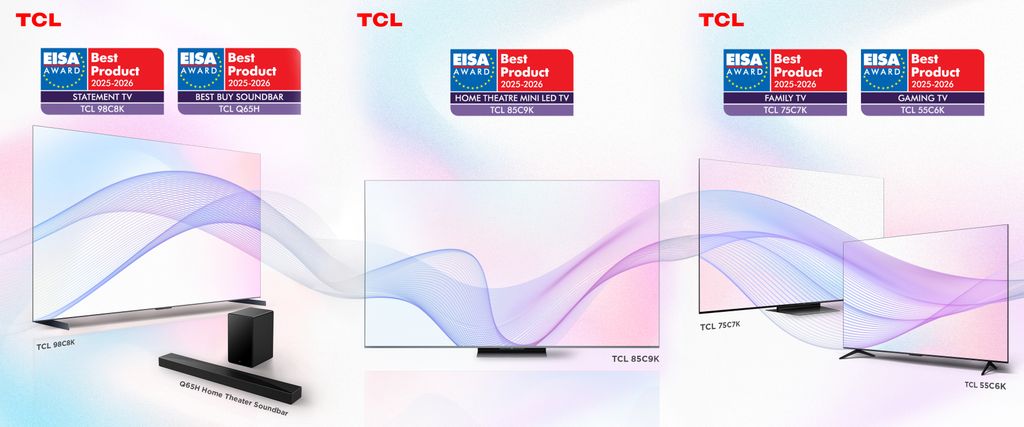- Matching (Score)
- Our verdict
- Competing TVs
- TV appearance
- Where to buy
- Contrast and black detail
- HDR effect quality
- Factory color reproduction
- Color reproduction after calibration
- Smoothness of tonal transitions
- Image scaling and smoothness of tonal transitions
- Blur and motion smoothness
- Console compatibility and gaming features
- Input lag
- Compatibility with PC
- Viewing angles
- TV efficiency during daytime
- TV features
- Apps
- Playing files from USB
- Sound
- Details about the matrix
Samsung S90F QD-OLED Review
S90F / FAT / FAE
Available screen sizes:
Diagonal with a different matrix: , , , ,

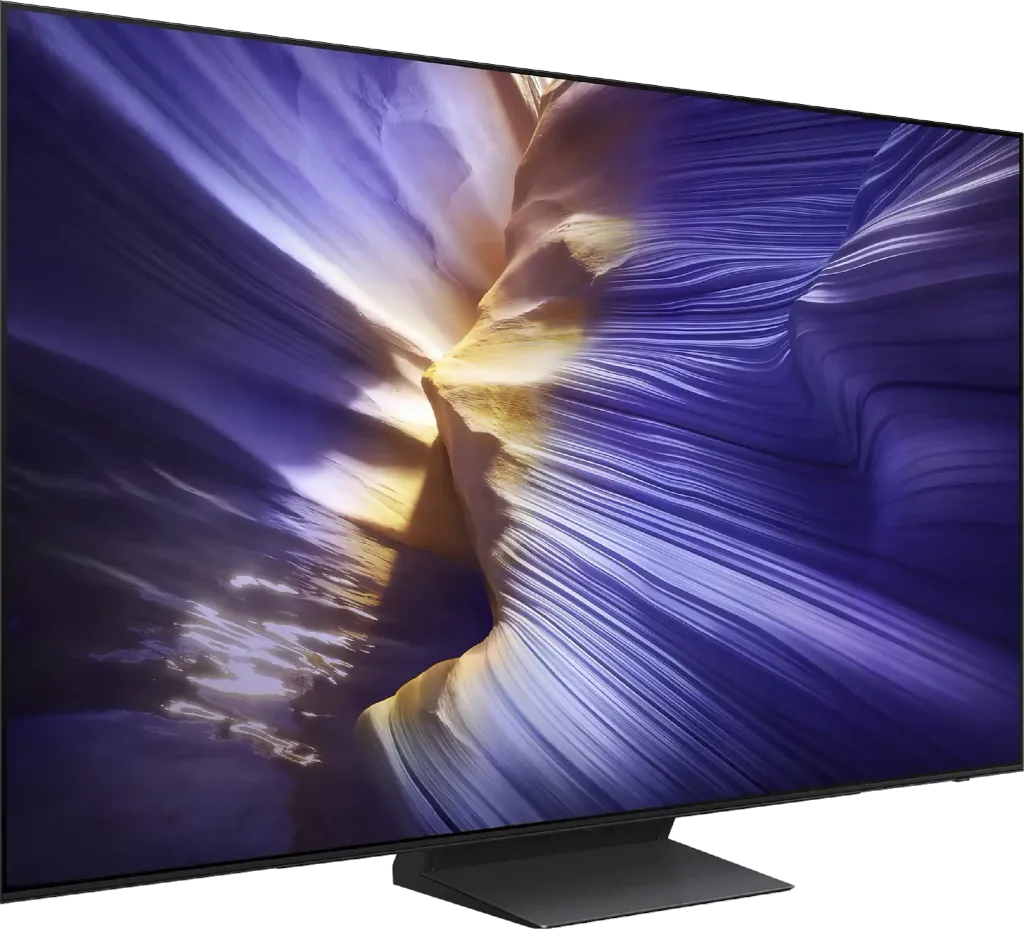
Complete the survey to find out the result
Panel type: QD-OLED Refresh rate: 144Hz Brand: SAMSUNG Resolution: 3840x2160 System: Tizen Model year: 2025
The matrix lottery is a phenomenon that no television enthusiast enjoys. When purchasing equipment, it is difficult to predict whether in a given size we will receive a panel from one factory or another, and this can significantly affect the quality of the image. This is exactly the case with the Samsung S90F series, where different versions use WOLED matrices, while others use QD-OLED panels. We have in our hands a 65-inch variant with the "FAT" suffix in its designation, equipped with a QD-OLED matrix. It is still an organic technology, but it differs from WOLED panels in several significant details that affect the image quality. What exactly are these details? And does the S90F in the QD-OLED version stand a chance of becoming the best OLED television of 2025 in terms of value for money? Let's find out!
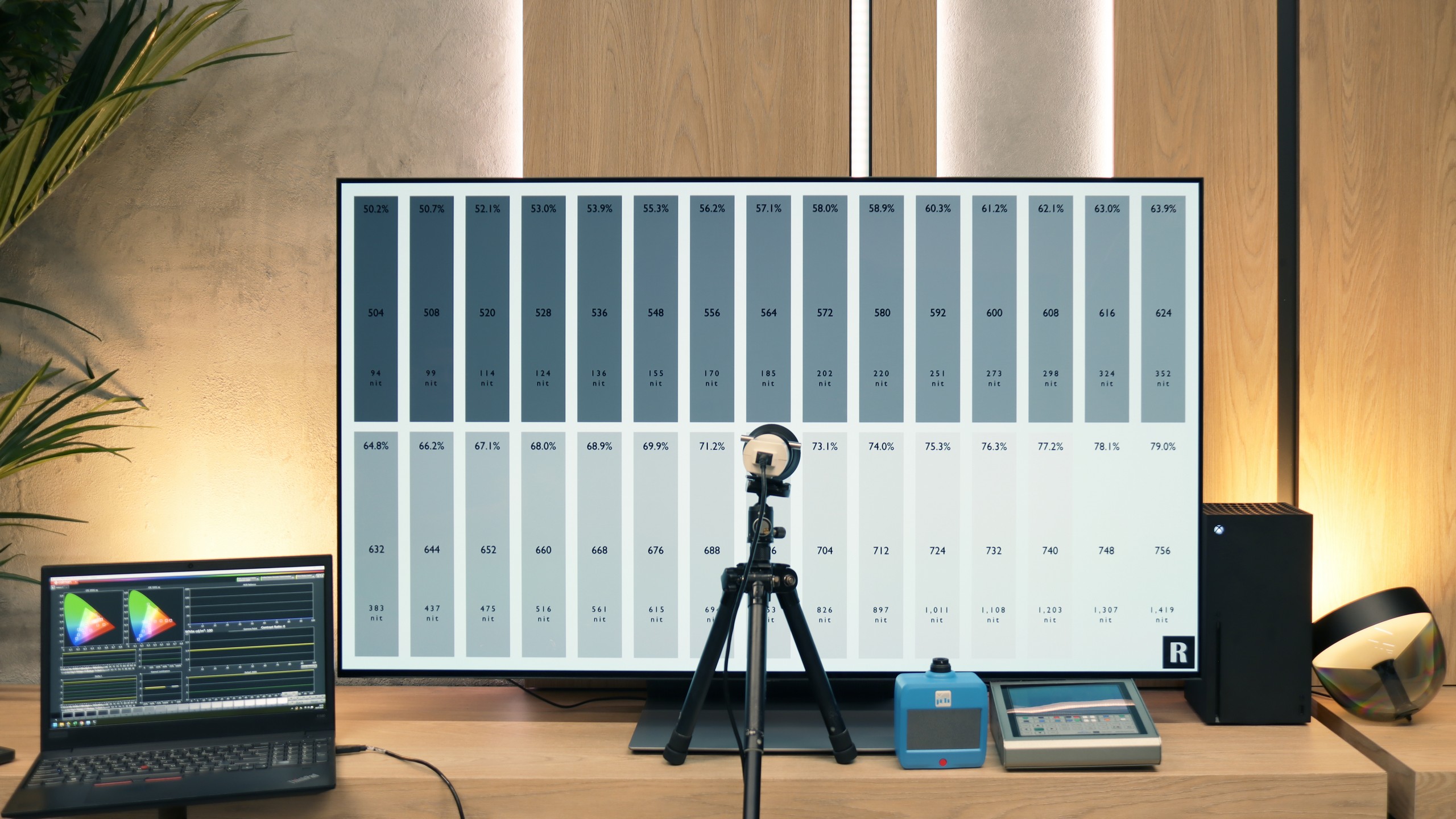
SAMSUNG OLED S90F - Our verdict
8.4
Overall rating
The Samsung S90F in the 65-inch version is a television that demonstrates the significant leap in quality that can be achieved with the use of a QD-OLED panel in a mid-range model. Compared to other variants, the S90F stands out as the best – it offers not only perfect blacks and infinite contrast like other options with a WOLED panel, but also noticeably higher brightness and a wider colour palette. This results in more impressive HDR, deeper colours, and smoother tonal transitions, which are impressive in both cinematic productions and in gaming or sports. In everyday use, it is an incredibly versatile television: it easily fits in as an entertainment hub in the living room, a large monitor for PC gaming, or simply a screen for evening film sessions. The Tizen system operates swiftly here, offering a wide selection of applications and integration with SmartThings, delighting those who like to have their smart home under control. Gamers receive a full suite of modern features: four full HDMI 2.1 ports, VRR, ALLM, a Game Bar with additional enhancements, and, most importantly, a remarkably low input lag. Additionally, there is the characteristic pixel response speed of OLEDs, which makes sports and games look simply outstanding. The S90F also defends itself in terms of design: slim bezels, an aesthetic finish, and a panel that resembles a sheet of glass all contribute to its appeal. The only significant limitation to keep in mind is the behaviour of blacks on QD-OLED panels in very challenging, heavily sunlit conditions. In such situations, it can slightly "light up," resembling a dark cherry colour rather than ideal black. However, in the evening, when most of us sit down for films or series – the problem disappears entirely. And then the S90F showcases its full capabilities, providing an image that can confidently be compared to televisions twice its price. This is precisely why the Samsung S90F in the 65-inch version can be called the most cost-effective OLED of 2025. It is a model that combines outstanding picture quality, versatility, and an affordable price in the mid-premium segment. If you are looking for a television that performs well in films, gaming, sports, and everyday viewing, yet you do not want to spend a fortune on absolute flagships – it is hard to find a better choice today.
Advantages
QD-OLED panel with remarkable black levels and contrast
Very high brightness for an OLED in this segment (around 1700 nits)
Excellent HDR effect and wide colour gamut coverage thanks to the use of quantum dots
Perfect viewing angles – the picture looks great even from the side
Effectively reduces reflections in bright living rooms
Stunning motion fluidity – 144Hz OLED panel
Full set for gamers: HDMI 2.1, ALLM, VRR, Game Bar, low input lag
Intuitive and fast Tizen system with a large app base
Good sound quality for a television + support for Dolby Atmos
High build quality and slim design
Disadvantages
In very strong daylight, black can tend to shift towards blue (characteristic of the QD-OLED panel)
Lack of support for DTS:X (a problem for Blu-ray enthusiasts)
No USB recording function from the built-in tuners
Why don't we find such a panel in all sizes?!
Movies and series in UHD quality
9.0
Classic TV, YouTube
9.3
Sports broadcasts (TV and apps)
8.9
Gaming on console
9.8
TV as a computer monitor
8.6
Watching in bright light
5.7
Utility functions
7.7
Apps
8.7
Sound quality
7.4
Complete the survey to find out what fits your preferences
SAMSUNG OLED S90F - Competing TVs in this price range
SAMSUNG OLED S90F - TV appearance
HDMI inputs: 0 x HDMI 2.0, 4 x HDMI 2.1 (48Gbps) Other inputs: Toslink (Optical audio), IR (remote) Outputs: Toslink (Optical audio), eARC (HDMI), ARC (HDMI) Network Interfaces: Wi-Fi 2.4GHz, Wi-Fi 5GHz, Ethernet (LAN) 100Mbps
Build quality: Premium
Stand type: Central
Bezel colour: Graphite
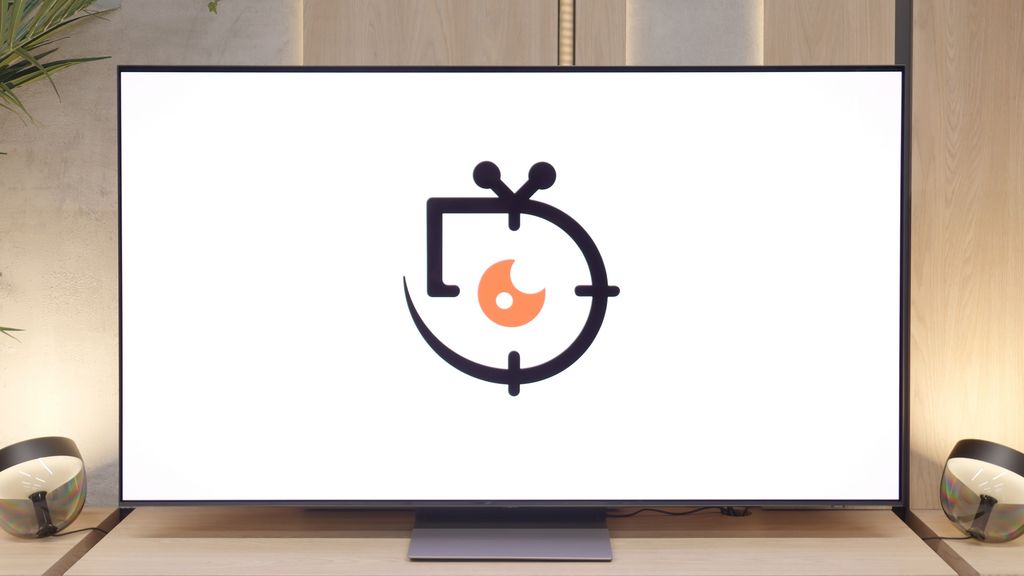
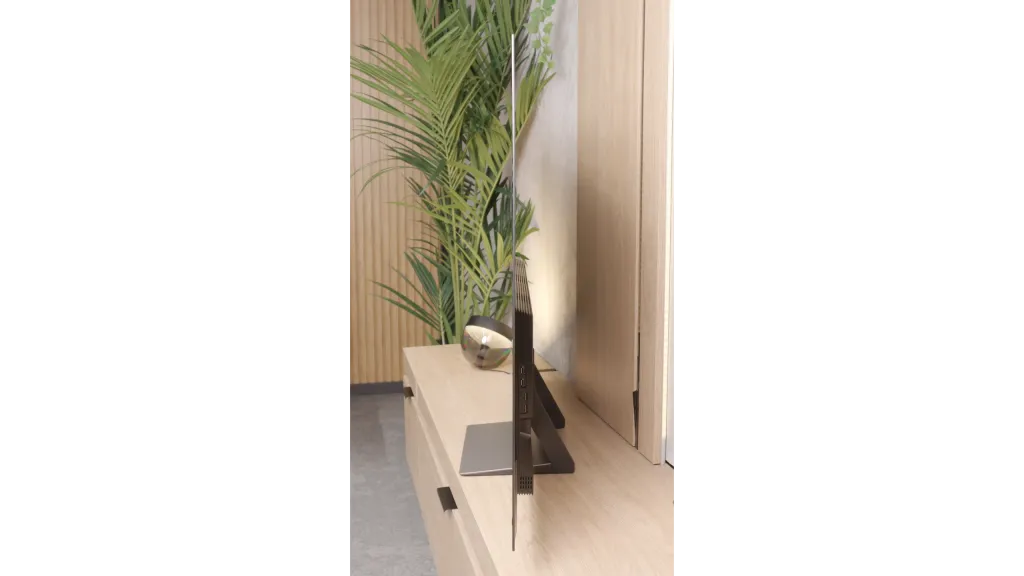
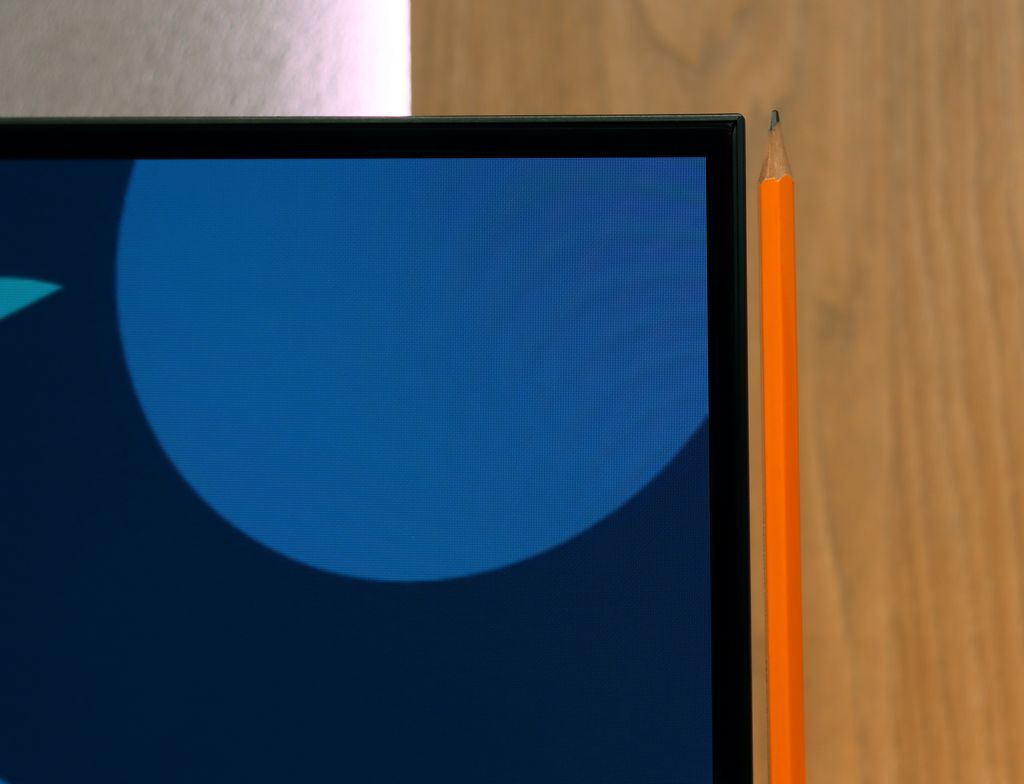
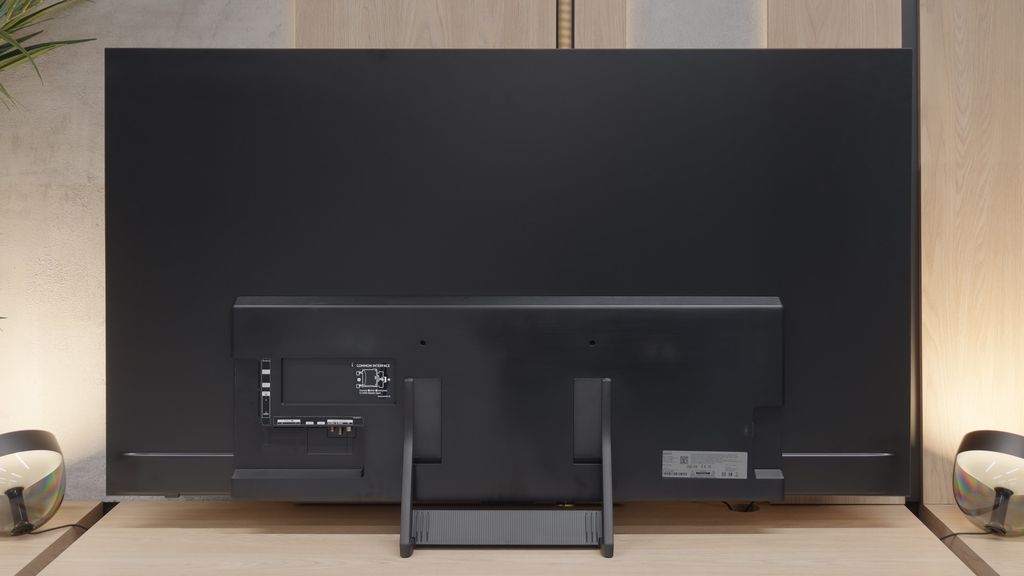
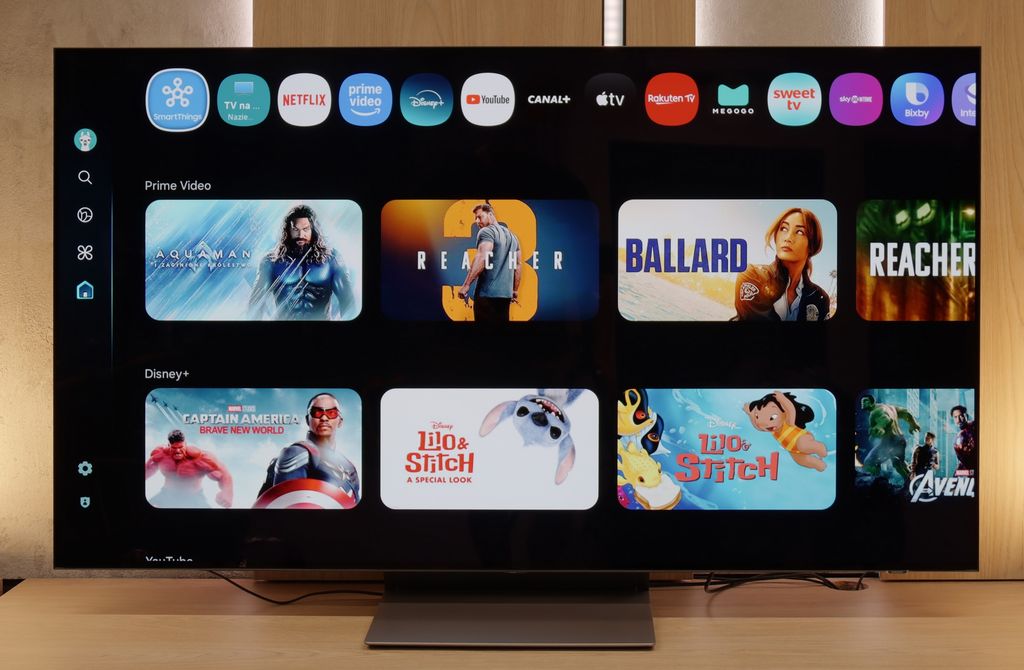
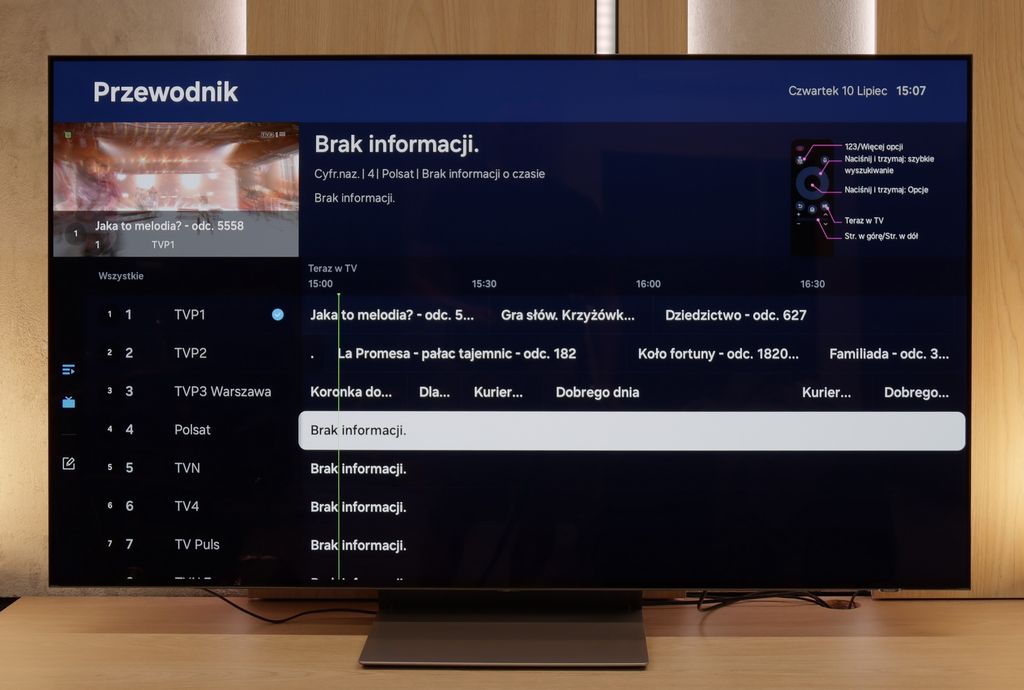
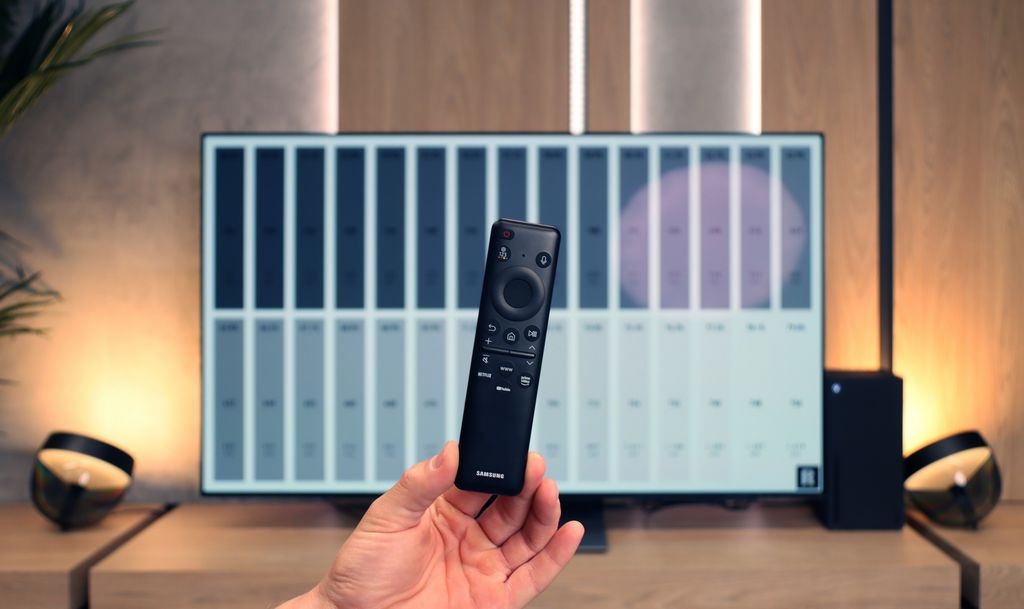
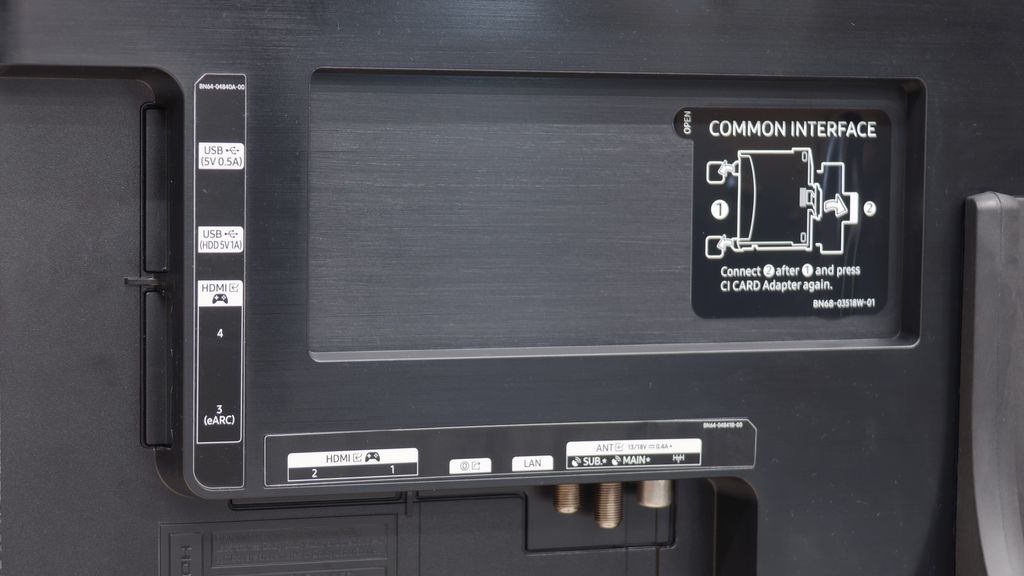
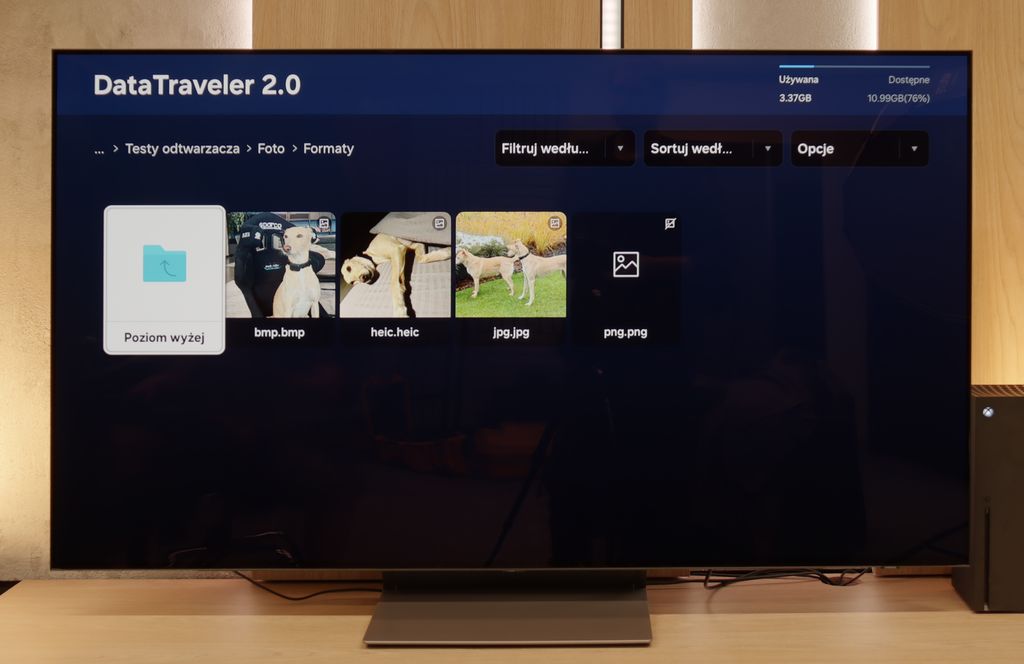
Stand: Fixed
Flat design: No
Accessories: Stand
The Samsung S90F is a television that immediately impresses with its appearance. Like every OLED, it delights with its extraordinarily sleek bezels, making the screen look like a uniform sheet of glass. The design with a slightly thicker back is typical for this type of panel, so it cannot be pushed completely against the wall, but the television is sleek enough that this shouldn't be a problem for anyone. Especially since all attention is drawn to the panel itself, which simply looks fantastic. The only element that could be criticised is the stand. The manufacturer opted for two plastic feet with a metallic-looking overlay, which doesn't quite match the rest of the construction. Aside from this detail, the S90F looks like top-tier equipment and will fit seamlessly into most modern interiors.
Buy in the best price
Select size:
SAMSUNG OLED S90F - Contrast and black detail
10/10

Result
∞:1

Result
∞:1

Result
∞:1

Result
∞:1

Result
∞:1
Visibility of details in the lights:
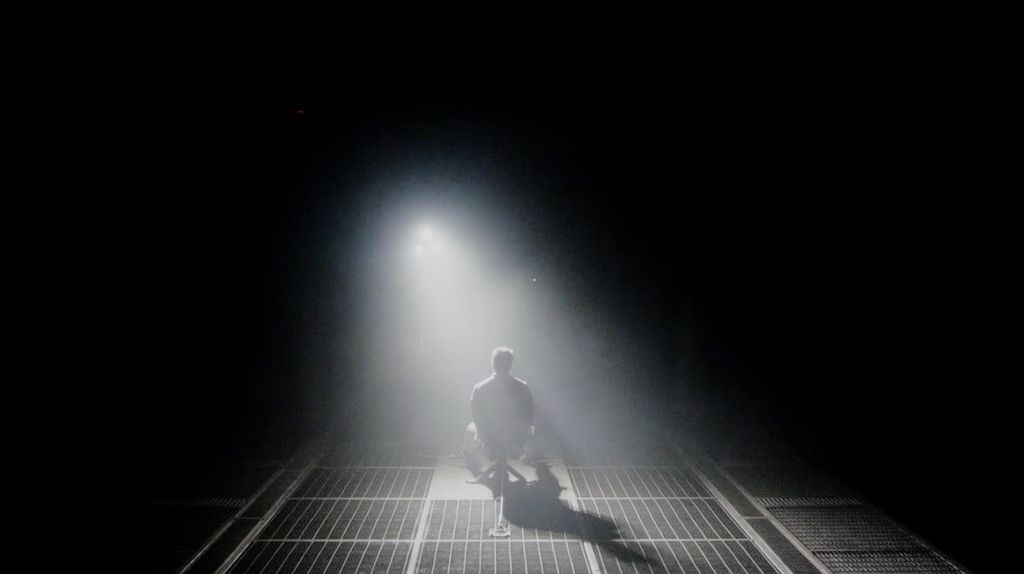
In terms of black levels and contrast, it doesn't matter whether we choose the WOLED or QD-OLED panel version for the S90F. In both cases, the effect in typical cinema conditions remains the same, and we can always count on perfect black. This impresses not only when watching films but also regular series. If someone has never encountered an organic matrix, the first meeting with such a television can truly captivate. It makes no difference whether we are looking at less demanding scenes, like those from the film Oblivion, or at parts where only a few details remain on the screen, such as stars in the sky in Star Wars – in every case, the image remains clear, and the details are perfectly separated from the background. This is one of the greatest advantages of OLED, as each pixel is controlled independently and acts as a separate zone. This means there is no need to worry about compromises in the visibility of details in bright areas, which can disappear even in the best LCD televisions. It is in cinematic conditions that the S90F showcases its full potential and can truly impress. Here, OLED technology – including the QD-OLED panel – performs flawlessly and delivers an effect that is hard to criticise.
SAMSUNG OLED S90F - HDR effect quality
7.8/10
Supported formats: HDR10, HDR10+, HLG Color gamut coverage: DCI P3: 99.6%, Bt.2020: 88.2%
Luminance measurements in HDR:

Result
1416 nit

Result
1585 nit

Result
1449 nit

Result
1379 nit

Result
808 nit
The biggest difference between the 65-inch S90F and the other versions is brightness. The QD-OLED panel can reach up to 1700 nits in laboratory tests, which is over 500 nits more than the variant with a WOLED matrix. This translates to a decidedly stronger and more engaging HDR effect. In most scenes, bright parts of the image look fantastic, and we must admit that we were positively surprised, as we expected results more similar to the WOLED version, but we got an effect that makes a great impression even in films. Just like with every OLED, there are moments when the panel needs to limit its brightness a bit. This mainly refers to full-screen, very demanding scenes – for example, in the last test frame from the film "The Meg," the brightness drops to around 800 nits. However, it is hard to consider this a disadvantage, as it is still an excellent result, unprecedented in OLED televisions in this price range. Everything suggests that the 65-inch S90F could be one of the best choices this year for those looking for a strong OLED at a reasonable price. Another advantage of the QD-OLED matrix in HDR content is its colour gamut coverage. Thanks to quantum dots, the television achieves almost a full 100% of the DCI-P3 colour space and nearly 90% of the BT.2020 colour space. These values place it alongside much more expensive models and make it exceptional in its class.
Scene from the movie “Pan” (about 2800 nits)

Scene from the movie “Billy Lynn” (about 1100 nits)

Being aware that the S90F with a QD-OLED panel can generate such high brightness, we had to compare it with the best screens on the market. And although it doesn't reach the level of this year's flagship OLEDs, considering the price segment it occupies, the effects can be summed up in one word: unparalleled. During screenings of films like 'The Gentleman' or 'Billy Lynn's Long Halftime Walk', we were truly surprised at how a "mid-range" OLED can meet the demands of such challenging titles. The image was very bright, but it didn't merge into a single luminous spot, and the details remained sharp and clear. In productions full of colours, a slight advantage of the QD-OLED panel was also noticeable, resulting from the higher saturation of colours, which adds extra depth and intensity to the whole. It's simply a fantastic screen for films.
HDR luminance chart:
HDR luminance
The S90F is a very bright television that excels in HDR10 format and can adapt the picture remarkably well to most content. In typical scenes, the effect looks impressive, but with extremely bright shots, there are instances where the brightness of the panel and its adaptation prove insufficient. In such moments, dynamic HDR10+ comes to the rescue, able to correct the picture and enhance details where the static format struggles. Of course, these are very rare cases, and in the vast majority of scenes, the S90F presents a full range of details effortlessly even without the help of dynamic metadata. Nonetheless, the presence of HDR10+ proves to be a valuable support, demonstrating its worth precisely in those most demanding situations.
Static HDR10

Dynamic: HDR10+

Factory color reproduction
7/10
Samsung S90F, like most modern televisions, offers several picture modes, but in line with our tradition, we tested it in the most important one, which is Filmmaker. This setting makes the image look much more natural than in the default, often overly saturated modes. It is neither excessively vivid nor artificially subdued – just closer to what one should actually see. However, this does not mean it is perfect. The S90F had noticeable shortcomings in white balance, mainly in the blue range, which gave a slightly yellowish filter effect on most scenes. One might argue that it looks more "filmic" because it is warmer, but let’s not kid ourselves – George Lucas didn't shoot Star Wars in sepia 😉 (a comparison with the scene can be found, as always, below). In HDR materials, there was also an issue with brightness management. The EOTF curve clearly showed that the television brightens the picture more than it should, leading to some effects appearing too intense and deviating from the reference. Fortunately, a large part of these shortcomings can be eliminated through professional calibration – we will discuss the effects of this procedure further on in the test.
Color reproduction after calibration
9.3/10
Calibration quickly revealed that the S90F has a significant margin of capability. The image in SDR immediately gained a natural quality – classic films no longer looked as if someone had applied a yellowish filter to them, and the colours regained their proper character. It is a return to the atmosphere of the original, without the impression that someone tried to "age" it forcefully. In HDR content, the difference was even more pronounced. The EOTF curve was managed almost to a reference level, and any deviations are so subtle that most viewers won't even notice them. In practice, the S90F shows an image very close to perfection after calibration. Compared to the WOLED version, it performs even better – mainly due to the wider colour gamut coverage, which makes the colours appear fuller and more intense.


SAMSUNG OLED S90F - Smoothness of tonal transitions
8.8/10
QD-OLED matrices, thanks to a very wide colour palette, simply have a greater number of colours, which facilitates the smooth blending of one shade with another. In the case of the S90F, this was clearly visible – compared to the classic version with the WOLED panel, we noticed a distinct improvement. Most transitions were smooth and practically invisible, and the image in most scenes appeared exceptionally cohesive. In very bright segments, minor imperfections can still be discerned, but they are cosmetic enough not to distract the viewer's attention.








Image scaling and smoothness of tonal transitions
7.5/10
Smooth transition function
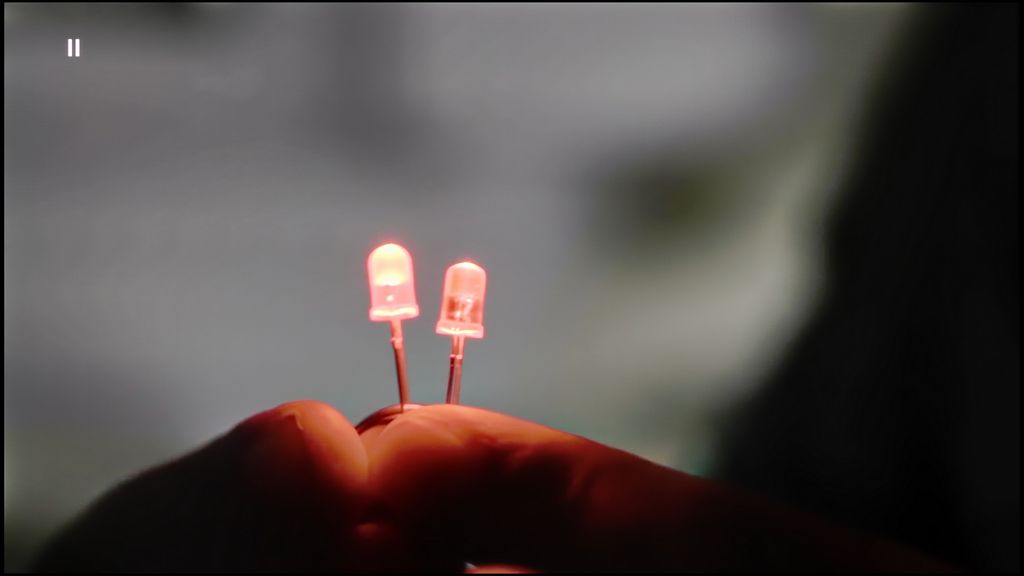
Image without overscan on the SD signal

The S90F performs really well here, although there are some comments that recur with most Samsung televisions. The noise reduction feature can effectively smooth out unwanted colour transitions in poorer materials, such as television or YouTube, making them simply look better. However, it should be noted that it operates quite aggressively and can also soften elements we wouldn't want to touch, like facial details. Therefore, if we want to use it, it’s best to set it to 'medium' and be aware of the compromise it entails. The upscaling itself is at a high level – low-quality materials are upscaled towards a 4K-like image. The only caveat is that the S90F can still struggle with so-called overscan, meaning it slightly trims edges with very poor materials like 576p and lower.
SAMSUNG OLED S90F - Blur and motion smoothness
8.5/10
Maximum refresh rate of the panel: 144Hz
Film motion smoothing option: Yes
Blur reduction option: Yes
BFI function 60Hz: Yes, 60Hz (image flickers)
BFI function 120Hz: No
Brightness drop with BFI: 50%
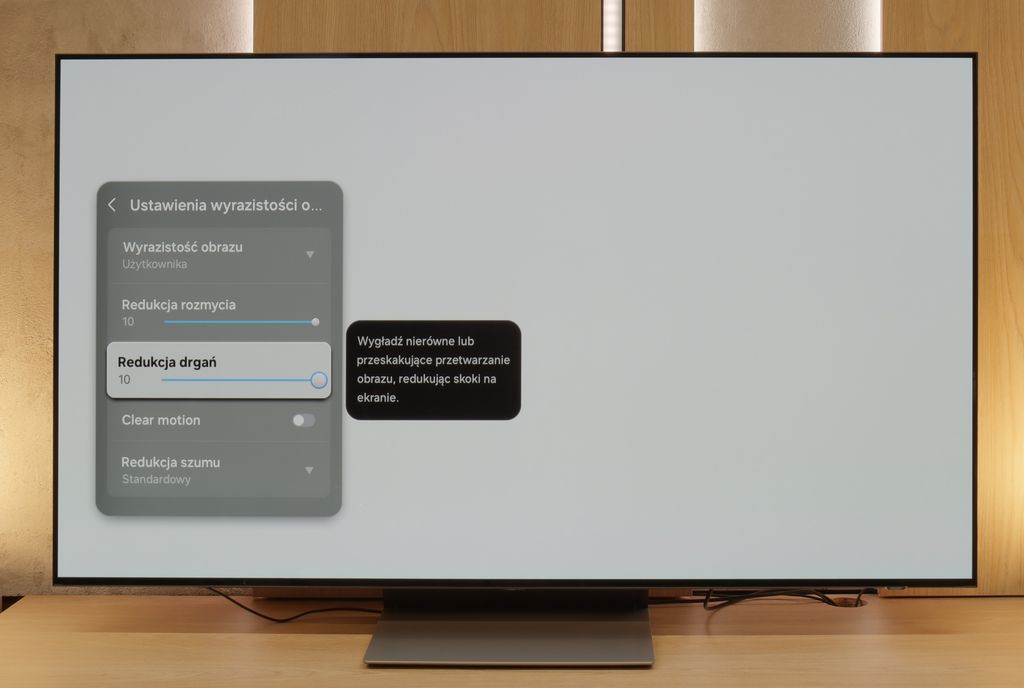
S90F is an OLED with a refresh rate of 144 Hz, but in practice, it primarily indicates how it performs at 120 Hz, as this frequency is most significant when watching sports. The QD-OLED panel is no different in this regard from WOLED panels – the response of the pixels is nearly instantaneous, so motion is rendered with surgical precision. The result is predictable. The image is virtually devoid of motion blur, making gaming on consoles, matches, or other sports broadcasts incredibly enjoyable on the S90F.
Fans of films and series have not been overlooked either. Like every Samsung television with a refresh rate of 120 Hz and above, the S90F features a proprietary motion smoothing technology called "Image Clarity." Here, we find two sliders – blur reduction and judder reduction – which allow for improved fluidity of materials recorded at 24 frames and tailoring the effect to personal preferences.
Blur (native resolution, maximum refresh rate):



Blur (BFI function enabled):
Image flickers in this mode



Smużenie (4K@144Hz):



When it comes to motion blur, this paragraph could actually remain empty. Whether we are using 144 Hz refresh in PC mode or 120 Hz on consoles and during sports, the problem virtually does not occur. The effect remains the same – the image is clear and free of blurring thanks to the organic panel used here. For those who would like to "smooth" motion even further, a BFI feature called Clear Motion is available. However, it should be noted that in this mode the image flickers significantly, and the practical value of this option is close to zero, as the panel already delivers excellent results without it being used.
SAMSUNG OLED S90F - Console compatibility and gaming features
9.6/10
ALLM: Yes
VRR: Yes
VRR range: 48 - 144Hz
Dolby Vision Game Mode: No
Correct implementation of HGIG: Yes
1080p@120Hz: Yes
1440p@120Hz: Yes
4K@120Hz: Yes
Game bar: Yes
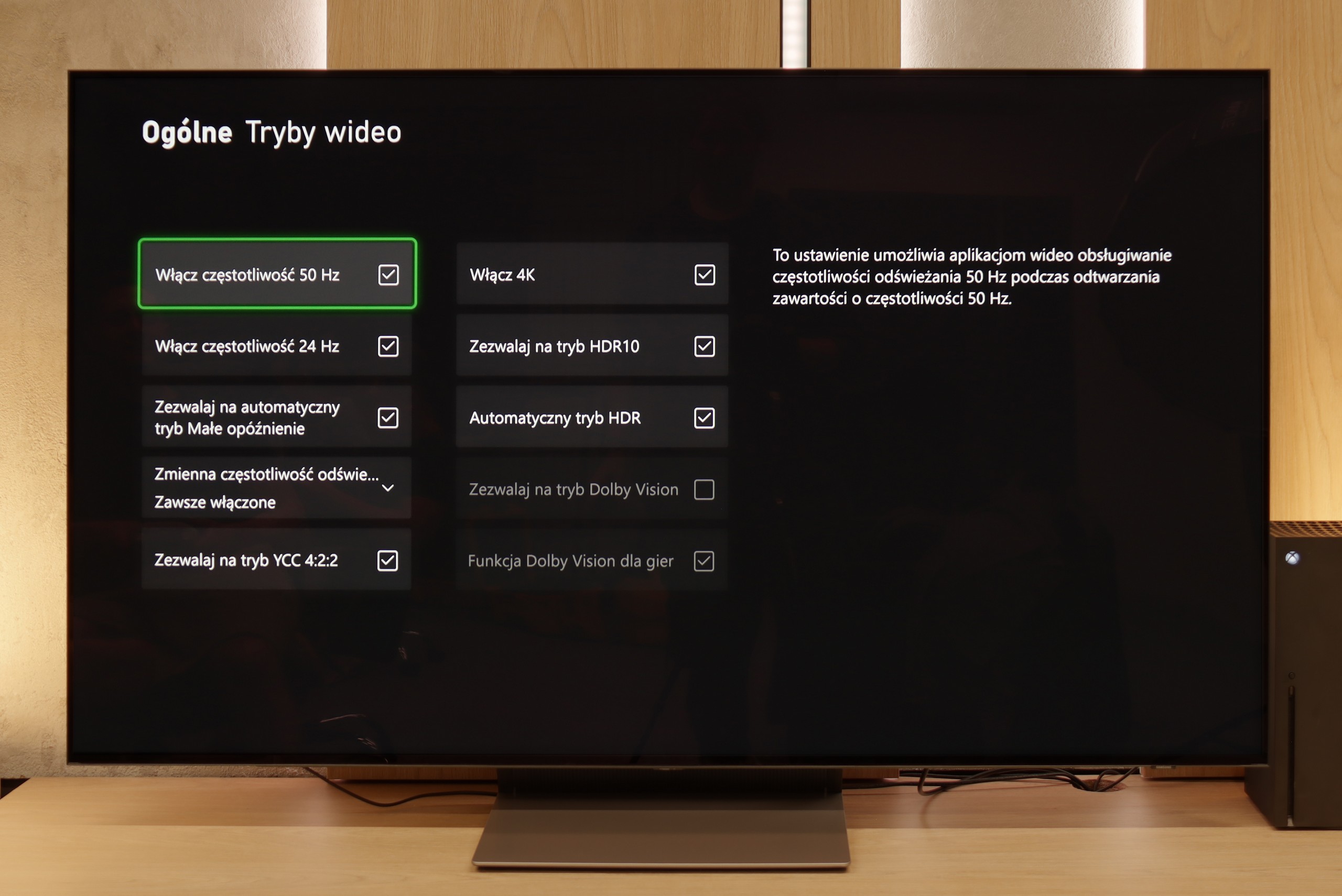
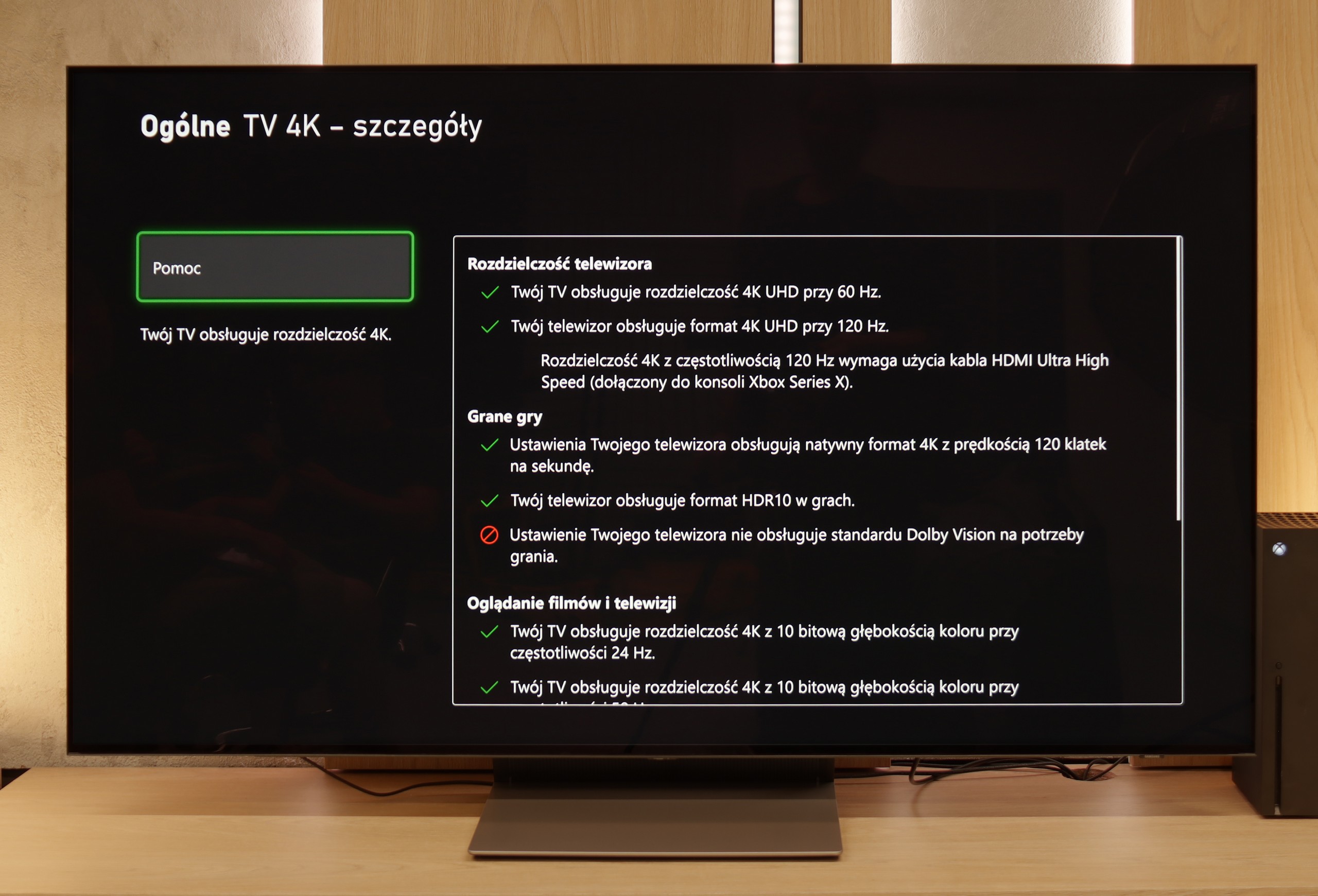
The S90F is a television that truly brings a lot of joy when gaming. To start, we have four full-fledged HDMI 2.1 ports, which means you can connect all consoles and PCs without worrying about which device has priority. This is a convenient and practical solution that is by no means a given with other manufacturers. Additionally, there are key features such as automatic game mode (ALLM), which automatically switches the screen to low-latency settings, and VRR frame synchronization that operates in a wide range from 48 to 144 Hz. As a result, the picture remains smooth regardless of whether we're playing fast-paced online shooters or more leisurely narrative titles. The Game Bar also deserves a mention – a panel that allows quick access to several useful additions. For example, you can enable an additional crosshair in the centre of the screen, enlarge the minimap, or, in the case of PC, change the aspect ratio. Lastly, there is also the unique Game Motion Plus mode from Samsung. Its purpose is to smooth out older or poorly optimized titles, and it actually works pretty well. Thanks to this mode, even less polished games can look better and provide a more enjoyable gaming experience than on other televisions that theoretically offer the same technical specifications.
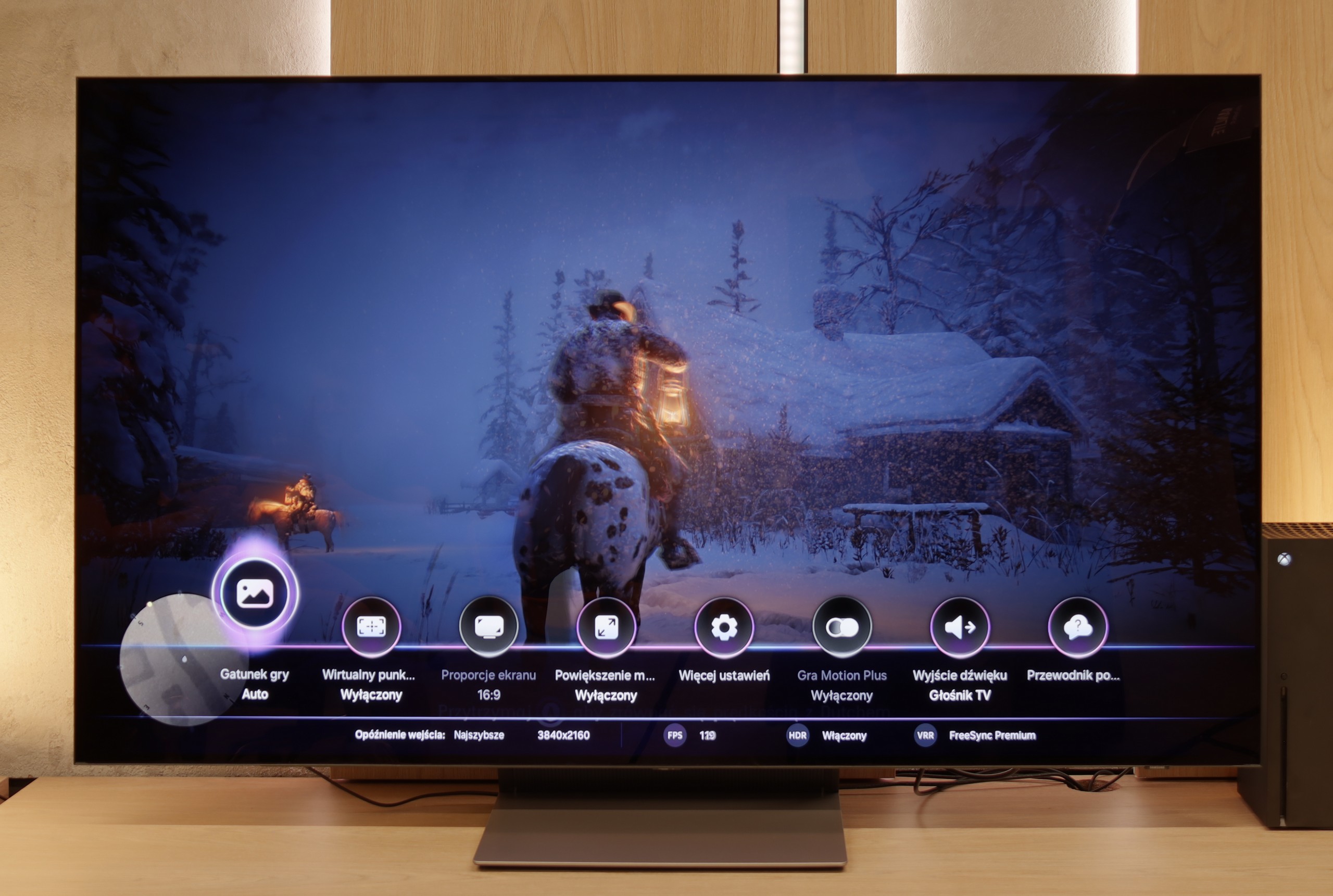
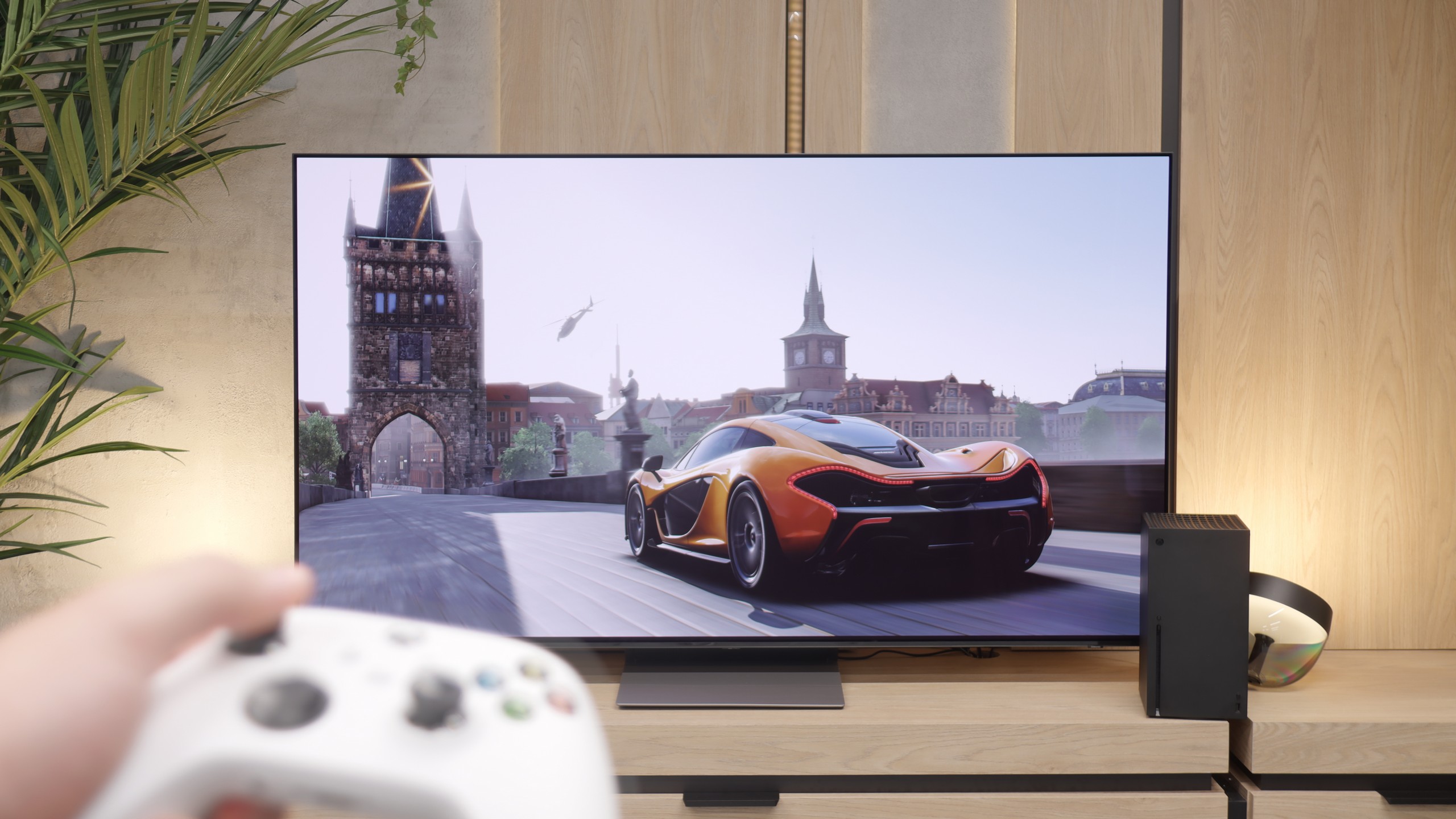

SAMSUNG OLED S90F - Input lag
10/10
In terms of latency, the S90F performs exceptionally well. With 120 Hz content, it is around 5 ms, and with 60 Hz, it's about 10 ms. In practice, this means an immediate response to the controller, mouse or keyboard – without the feeling that something is slowing down the gameplay!
| SDR | HDR | Dolby Vision |
|---|---|---|
| 1080p60: 10 ms | 2160p60: 10 ms | |
| 1080p120: 5 ms | 2160p120: 5 ms | |
| 2160p60: 10 ms | ||
| 2160p120: 5 ms |

SAMSUNG OLED S90F - Compatibility with PC
8.6/10
Chroma 444 (maximum resolution and refresh rate): Yes
Font clarity: Very Good
Readability of dark text and shapes: Good
Input lag in PC mode (4K, maximum refresh rate): 5ms
Matrix subpixel arrangement: RGB
Max refresh rate: 144Hz
G-Sync: Yes
The S90F, even in the 65-inch variant, performs excellently as a large monitor for PCs. The greatest benefits are, of course, for gamers – the television supports a refresh rate of up to 144 Hz, as well as frame synchronisation with Nvidia (G-SYNC) and AMD (FreeSync) graphics cards. The difference compared to WOLED panels lies in the distinctive "diamond" pixel arrangement in QD-OLED. In practice, this can affect the display of fine text – some letters at the edges may have slightly jagged shapes. On the other hand, in WOLED matrices with a layout of four subpixels, the text can be less precise, so each variant has its own minor specifics. In both cases, however, the television is very well suited for both gaming and occasional work on a computer.
SAMSUNG OLED S90F - Viewing angles
9.8/10
Brightness drop at an angle of 45 degrees: 10%
One of the things that immediately impresses in the S90F is its viewing angles. This is the huge advantage of QD-OLED panels – even if we are not sitting perfectly in front of the television, the image hardly changes. Colours remain vibrant, contrast strong, and details just as clear as when viewed from a central position. Therefore, one can comfortably watch a film with several people, spreading out across the entire living room, without worrying that someone will receive a washed-out version of the picture. OLEDs have always performed well in this category and this is one of their main advantages over classic LCDs. However, in QD-OLED, the difference is even more apparent – the image maintains its quality even at a steep angle, where on WOLED panels one might begin to notice a slight loss of colour intensity. Here, that is practically absent.
SAMSUNG OLED S90F - TV efficiency during daytime
5.7/10
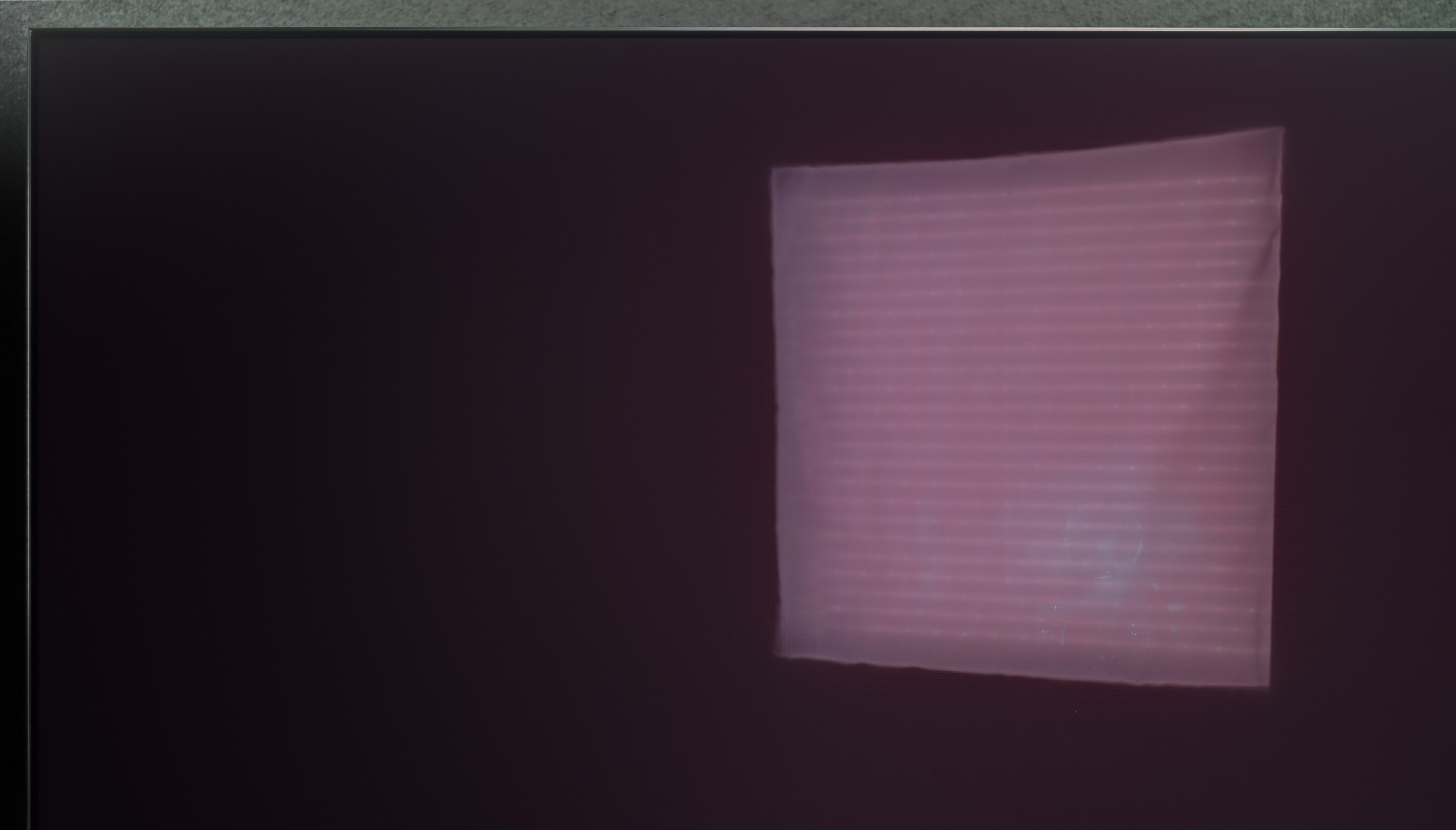
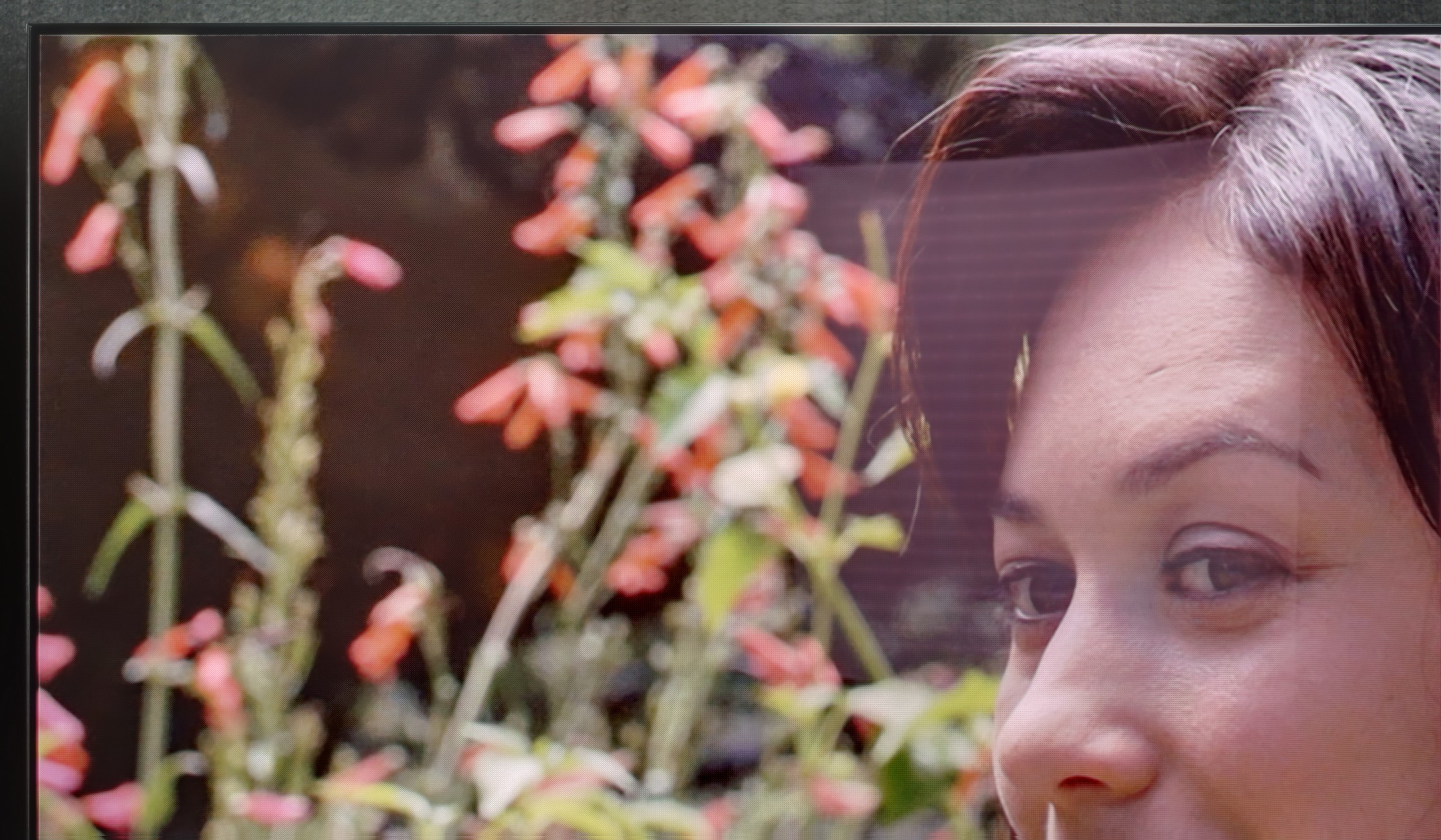
Matrix coating: Glare
Reflection suppression: Good
Black levels during daytime: Average
QD-OLED panels have their Achilles' heel – it is the reproduction of black in heavily sunlit rooms. The glossy coating used here deals with reflections quite well, definitely better than in the WOLED panels we had the chance to test. The problem is that under very intense daylight, black can take on a dark navy hue and loses its depth. Fortunately, in the evenings, this phenomenon disappears completely and the television shows an image that we expect from OLED – with perfect contrast and true black. As for brightness itself, the S90F performs quite well for a mid-range OLED. In typical conditions, it handles without issue, and the screen will look attractive even in a well-lit living room. It is only in really extreme conditions, when the sun shines directly on the screen, that it may be more challenging, but this is a drawback of all OLEDs in this price segment. On the other hand, better suppression of reflections means that for many people, QD-OLED will prove to be more comfortable for daily viewing than traditional WOLEDs, despite the fact that blacks do not always look perfect on it.
Matrix brightness
Average luminance SDR
Samsung S90F QD-OLED: 431 cd/m2
SAMSUNG OLED S90F - TV features
7.7/10
System: Tizen
System performance: Very good
- HDMI inputs: 0 x HDMI 2.0, 4 x HDMI 2.1 48Gbps
- Other inputs: Toslink (Optical audio), IR (remote)
- Outputs: Toslink (Optical audio), eARC (HDMI), ARC (HDMI)
- Network Interfaces: Wi-Fi 2.4GHz, Wi-Fi 5GHz, Ethernet (LAN) 100Mbps
- TV reception: DVB-T, DVB-T2, DVB-S, DVB-S2, DVB-C
Classic features:
Recording to USB (terrestrial TV): No
Recording programming: No
Picture in Picture (PiP): Yes
RF remote control (no need to aim at the screen): RF
Backlit remote control: No
Teletext: Yes
Audio only mode: Yes
Bluetooth headphones support: Yes
Simultaneous Bluetooth headphones & TV audio: Yes
Smart features:
AirPlay: Yes
Screen mirroring (Windows Miracast): Yes
Voice search: Yes
Voice search in native language: Yes
Ability to connect a keyboard and mouse: Yes








SmartTV Features: Tizen.
A major advantage of the S90F in daily use is the Tizen operating system. It is one of the fastest systems on the market and has been working exceptionally well on Samsung televisions for years, and on higher-end models like this one – it works instantly. The menu responds without delays, switching between apps is smooth, and the whole system is intuitive enough that even someone encountering Smart TV for the first time can navigate it easily. In the app store, we can find practically everything needed – from Netflix to HBO Max, as well as less obvious services. Perhaps GoogleTV is not available here, but in reality, there is no sense that something is lacking. A big plus is the integration with SmartThings. This solution is for those who like to have their entire home under control in one app. The television can be part of the IoT device ecosystem and easily communicates with the washing machine, air conditioning, or lighting, as long as everything is on the same network.
Classic Functionalities
When it comes to classic functionalities, we have everything one could expect: support for HDMI 2.1, USB ports, optical output, and connectivity via Wi-Fi and Bluetooth. The only thing that might be lacking for more conservative cinema fans is support for DTS:X audio formats – especially if someone watches films on physical media. The remote control may initially seem a bit strange, as it lacks traditional number buttons. But this is now standard in today’s television world, and most users adapt to it quickly. A plus is that it works completely wirelessly. The point is that you don’t need to aim at the screen, you just have to press a button on the remote from anywhere (even in another room), and the television responds to our actions.
Sound connection options
HDMI audio:
Other audio outputs:
Toslink: Yes
Wireless audio:
Bluetooth: Yes
Obsługiwane formaty audio:
Dolby Digital Plus 7.1: Yes
Dolby True HD 7.1: No
Dolby Atmos in Dolby Digital Plus (JOC): Yes
Dolby Atmos in Dolby True HD: No
DTS:X in DTS-HD MA: No
DTS-HD Master Audio: No
Ułatwienia dla seniorów
Numeric keyboard on TV: No
Font size adjustment: Yes
Audio description: Yes
SAMSUNG OLED S90F - Apps
8.7/10























SAMSUNG OLED S90F - Playing files from USB
9.1/10

| Maximum photo resolution: | Supported photo formats: |
|---|---|
The built-in player in the S90F works really well and is sufficient for most users. It easily opens films or music stored on a USB drive or external hard drive and handles most popular formats. The only "more serious" issue we encountered was the lack of support for HEIC photos – those that can be saved by an iPhone. (Although we suspect that 90% of users are still using the JPEG format).
SAMSUNG OLED S90F - Sound
7.4/10
84dB
Maximum volume
Supported codecs
(TV speakers)
Dolby Digital Plus 7.1
Dolby True HD 7.1
Dolby Atmos in Dolby Digital Plus (JOC)
Dolby Atmos in Dolby True HD
DTS:X in DTS-HD MA
DTS-HD Master Audio
The S90F plays really nicely for a television – the bass is noticeable, the dialogue sounds clear, and the overall dynamic is quite good. Dolby Atmos also does its part, as it can add a bit of space to the sound, making movie watching better than in most basic built-in sets found in other televisions. However, it must be stated clearly: no television, even of this class, can replace a separate sound system. If someone really wants to feel like they’re in a cinema, the best solution would be to purchase a soundbar or a full audio system. Especially since, as is often the case with Samsung, there is a lack of support for DTS:X – so fans of Blu-ray discs and high-quality soundtracks will still have to reach for external equipment connected directly to the source.
Acoustic Measurements
84dBC (Max)
75dBC
SAMSUNG OLED S90F - Details about the matrix
Software version during testing: T-RSMFDEUC-0090-103 2.5, E2500007, BT-S
Subpixel Structure:
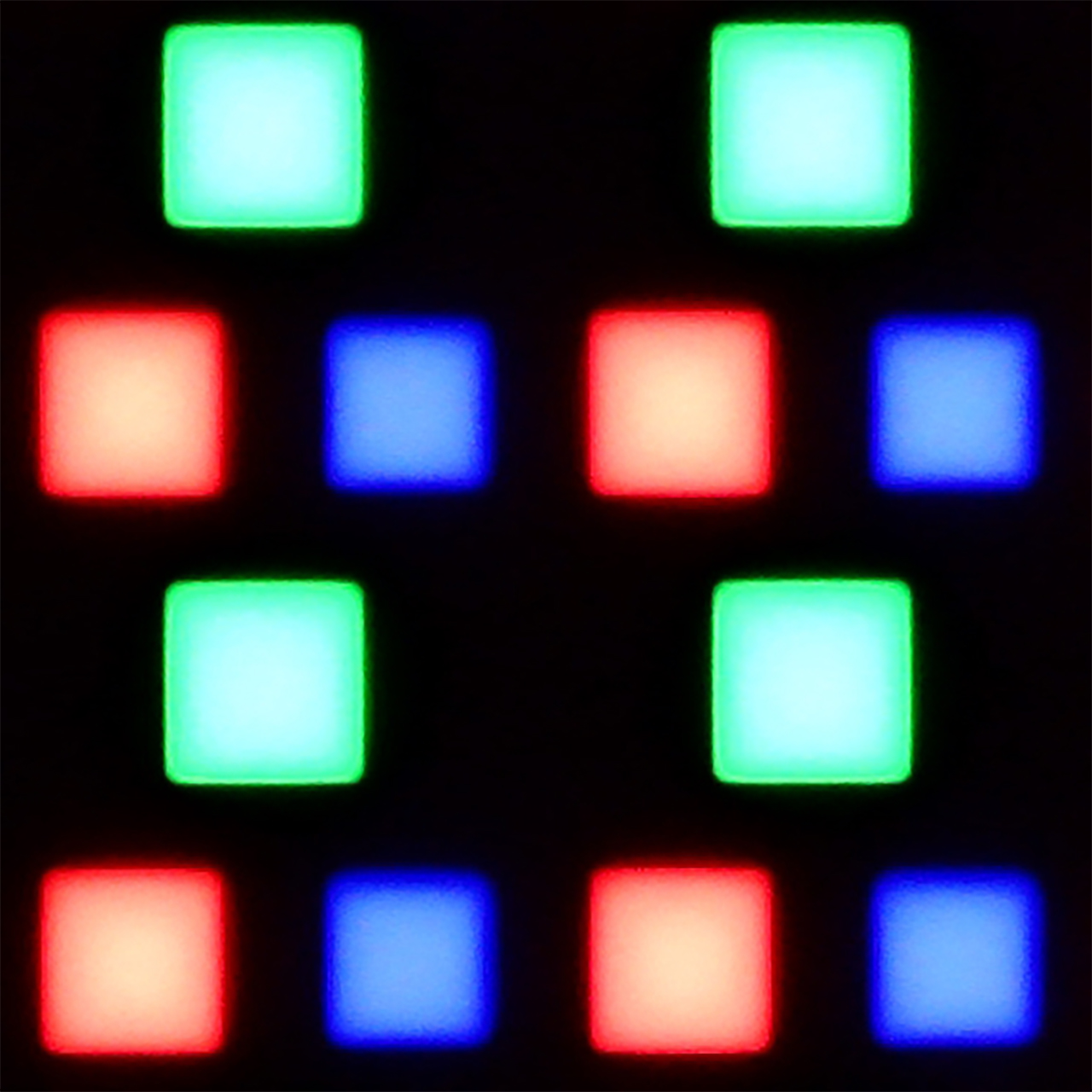
Panel uniformity and thermal imaging:

Founder and originator of the "ChooseTV" portal

Journalist, reviewer, and columnist for the "ChooseTV" portal
See articles related to Samsung S90F QD-OLED:
4/3/2025







